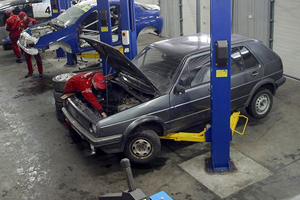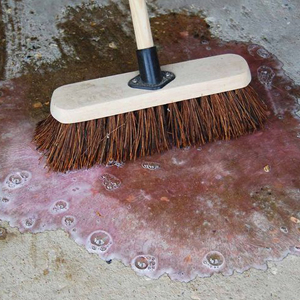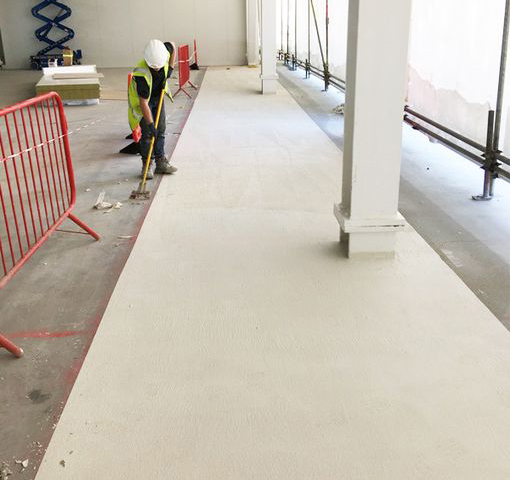Oily floors can be a problem, especially if the oil has penetrated into the pores of the concrete. Sometimes, even after cleaning, grease and oil will still be present though the surface looks clean.
Watco Concroff is ideal for this. It is a powerful, environmentally friendly emulsifying degreaser. It will break down the oil and grease and ‘lift’ it out of the concrete. This is important because a lot of concrete cleaners only tend to clean the top of the concrete rather than penetrating or end up smearing an oily residue over the whole floor.
It’s easy to use - pour it onto the floor working it in using a broom. Leave it for around 15 – 30 minutes to break down the grease, then give it another stiff brush, or, if you prefer, use a mechanical scrubber to clean up and a wet vac to collect the dirty water. If you suspect that the floor has been heavily contaminated, it would be best to leave the degreased floor for a day or two to see if any further grease or oil rises to the surface. If it does, repeat the process making sure that the concrete is dry before re-applying Watco Concroff.
You will now have a really clean, oil free floor, which is ready for painting!
If the concrete seems impossible to get clean, or, when you do get it clean, more oil just rises up to the surface, use Watco Oil Block Primer. After the first surface clean (to get rid of any build-up of grease and oil), roller out the primer and it will seal in any remaining oil contamination. It will be dry and ready to paint the next day.
 |  |
Top Tips:
It is important to use a degreaser which is powerful enough to break down and remove grease and oil, but gentle enough that it won’t damage the existing paint.

Watco Bio D is a solvent free, biodegradable emulsifying detergent which is ideal for use on previously painted floors. Although it’s solvent free, it’s as effective as a traditional solvent based cleaner. It will not ‘bleach’ the existing paint or soften it, whereas solvent based ones will. It can also be used in confined spaces and is odourless.
Its emulsifying action means it will break down light to medium contamination of oil and grease and ‘lift’ it out of the floor.
Application is simple - just brush in the undiluted Watco Bio D with a stiff broom and leave for roughly 5-10 minutes so that it can penetrate, then scrub it with a stiff broom or mechanical scrubber and rinse away with clean water.
Tip – Watco Bio D is also really effective on dirty and oily machinery and it brings it up looking like new.

Watco Powerfloat Primer is especially formulated to allow smooth or painted surfaces to be painted or repainted successfully.
Most floor paints rely on being able to penetrate (or “wet-out”) into the concrete. They can flake or peel if they just sit on the surface. Sometimes concrete is trowelled to such a smooth, dense surface that it is not porous, so paint could fail because it cannot be absorbed. The traditional way of “opening up” such hard, smooth or “powerfloated” surfaces is by abrading it or perhaps shot blasting, but this can often be time consuming, messy/dusty and expensive.
Application of Watco Powerfloat Primer is straightforward; just stir the tins of resin and curing agent, then tip each small tin into the tall outer tin and mix together using our paint mixer or a wide bladed tool such a wooden batten. Mix it for 2–3 minutes until it is streak free and looks even in colour. Then, just tip it all into a shallow tray and apply it using a medium pile sheepskin roller (we can apply all the tools you need for the job!). Use a paint brush for cutting in around the edges.

The primed surface can be painted with one of Watco’s range of water based coatings after 16 hours, or only 3 hours if the rapid version is used. Allow five days for solvent based coatings such as Watco Concrete Floor Paint.
TIP – To see if you need Watco Powerfloat Primer, pour a cupful of water onto your hard, smooth or power-floated concrete. If the water soaks in, it is fine to be painted. If the water beads up on the surface and doesn’t disappear, it shows that the concrete will not absorb the paint and Watco Powerfloat Primer would be strongly recommended.
Most uncoated concrete floors are porous and if you put a coating directly on the screed without preparing it, the paint will just seem to disappear! This is easy to overcome by applying a coat of Watco 4 Hour Epoxy Primer.
It’s a two pack, solvent-free primer designed to reduce the porosity and help strengthen the screed and bind it together prior to coating it. This is important – porous screeds such as sand and cements lack the strength of concrete and as the surface weakens, it can lead to premature wear of a new paint coating. Another added benefit is that you only need one coat so you can prime and overcoat in just one day and get the area back into use quickly.
It’s easy to use - just mix the two liquid components together and tip into a plastic tray. Apply it with a 9" roller (not a foam one). You can use a paint brush for cutting in round the edges. Assuming the floor temperature is around 10-15˚C and the room is well ventilated, you can overcoat it within 2-4 hours; basically, if it’s dry to the touch, it’s ready to be painted.

New concrete flooring should to be left for around 4–6 weeks to dry. This is based on reasonable drying conditions; if it is laid in the depths of winter, allow nearer 8–10 weeks. Once it’s dry, use Watco Etch & Clean - it neutralises any alkalinity, provides a good key for a coating to bond to and is an easy way to remove any light deposits of dust and dirt which often form on new concrete. If the dust and dirt isn’t removed, the paint will stick to the dust and when it’s put back into use, it will all just flake away.
Etch & Clean is an acidic floor cleaner but don’t let this put you off. It is easily applied by pouring onto the surface from the plastic container. Apply it reasonably evenly to the floor, then work it in using a stiff broom or hire a floor scrubber for larger areas. You should see it froth or bubble as it reacts with the concrete – this shows it’s working.
Leave it for 20 minutes until it’s stopped fizzing and hose it away with cold water. Leave the floor to dry or collect with a wet vac. Don’t worry about hosing it away too much though, because the water you’re left with is no longer acidic as the Etch & Clean will have been neutralised by the alkalinity of the concrete.
The concrete will look clean, white and dust free – it will look like it is ready to be painted
If a concrete floor is generally just dusty, a good sweep is usually sufficient. If there are dirt and oily patches to remove, the best way to tackle this is with Watco Bio D.
It’s a high performance solvent free cleaner that easily cuts through general dirt, grease and fat. It’s gentle enough to use on painted floors but strong enough to lift grime from bare concrete floors. It’s also a biodegradable cleaner.
The coverage is really good too, which makes it extremely economical to use. 5 litres can be diluted to clean 20m².
Application is simple - using a broom sweep it evenly over the floor, leave for roughly 5–10 minutes to give it enough time to break down any grease. Then give it a good sweep with the broom, flush it away with clean water and leave it to dry. For larger areas you may find it easier to hire a scrubbing machine and a wet vac.
It’s a low foaming, low streak formula that doesn’t leave a dull residue on the surface and because it dissolves the grease, you won’t be left with any slippery patches!
If the concrete is dirty (not oily), really hard and smooth, use Watco Etch & Clean in place of Watco Bio D. Watco Etch & Clean is an acidic based cleaner which “etches” bare concrete allowing the new paint to penetrate and form a key. It’s also really effective in removing dust, dirt and any loose cement deposits which otherwise cause paints to fail. Watco Etch & Clean is not difficult to use or dispose of; the alkalinity of bare concrete neutralises the Watco Etch & Clean acidity, so all you’re left with to flush away, is dirty water.
Watco New Concrete Primer would be ideal for priming new concrete floors, providing the concrete or sand and cement screed is hard enough to walk on and the surface is not too damp (usually about 1–2 weeks after laying new concrete).
This primer works by holding back the construction moisture in new concrete (although it’s not an alternative to a missing or defective damp proof course), which means you can apply your paint finish over the top of the Watco New Concrete Primer after just 48 hours.
It’s easy to use; just make sure the surface is sound, clean and dry. If the substrate is polished or very smooth, you will need to lightly abrade it to get a good key. This will ensure the Watco New Concrete Primer bonds really well. If it’s a large area, I would recommend either shot blasting it or using a scarifying machine.
Application is straight forward - just mix the tins of resin and curing agent together, using a slow speed drill fitted with a paddle, and pour it over the floor and spread it with a notched trowel. While it’s still wet, finish off by flattening it down with a long handled roller.
.jpg)
Top Tips:

If you have a rising damp or general damp problem, this has to be sealed in before you can paint it. Watco Liquid Waterproofer is ideal for this. In fact, the floor must be damp or wetted first in order for this to work.
Watco Liquid Waterproofer acts as a damp proof membrane and will hold back damp and rising damp and provides a waterproof coating. It not only holds water back but can also be used to ‘contain’ it making it perfect for water storage areas and ponds (it won’t harm fish).
Another benefit is that it’s thick and flexible, so it will cope with some movement and will fill minor cracks too.
To apply it, just mix the Watco Liquid Waterproofer powder with the liquid. Make sure the floor is damp before applying the first coat, (this is important or the Watco Liquid Waterproofer will not sink in), and apply the first coat with a medium pile roller or short bristled brush. A medium pile roller leaves a textured finish. If you want it smooth, either use a squeegee to apply the product or finish with a smooth short pile roller. The second coat can be applied as long as the first coat has dried (usually after 12-24 hours depending on temperature). The total thickness after the two coats have been applied should be somewhere in the region of 1-3mm.
You can either leave it as it is, or if you would prefer to paint it, leave it for 24-48 hours (depending on drying conditions and temperature) then use any of our water-based coatings such as Watco Epoxy Gloss Coat.
Top Tips: